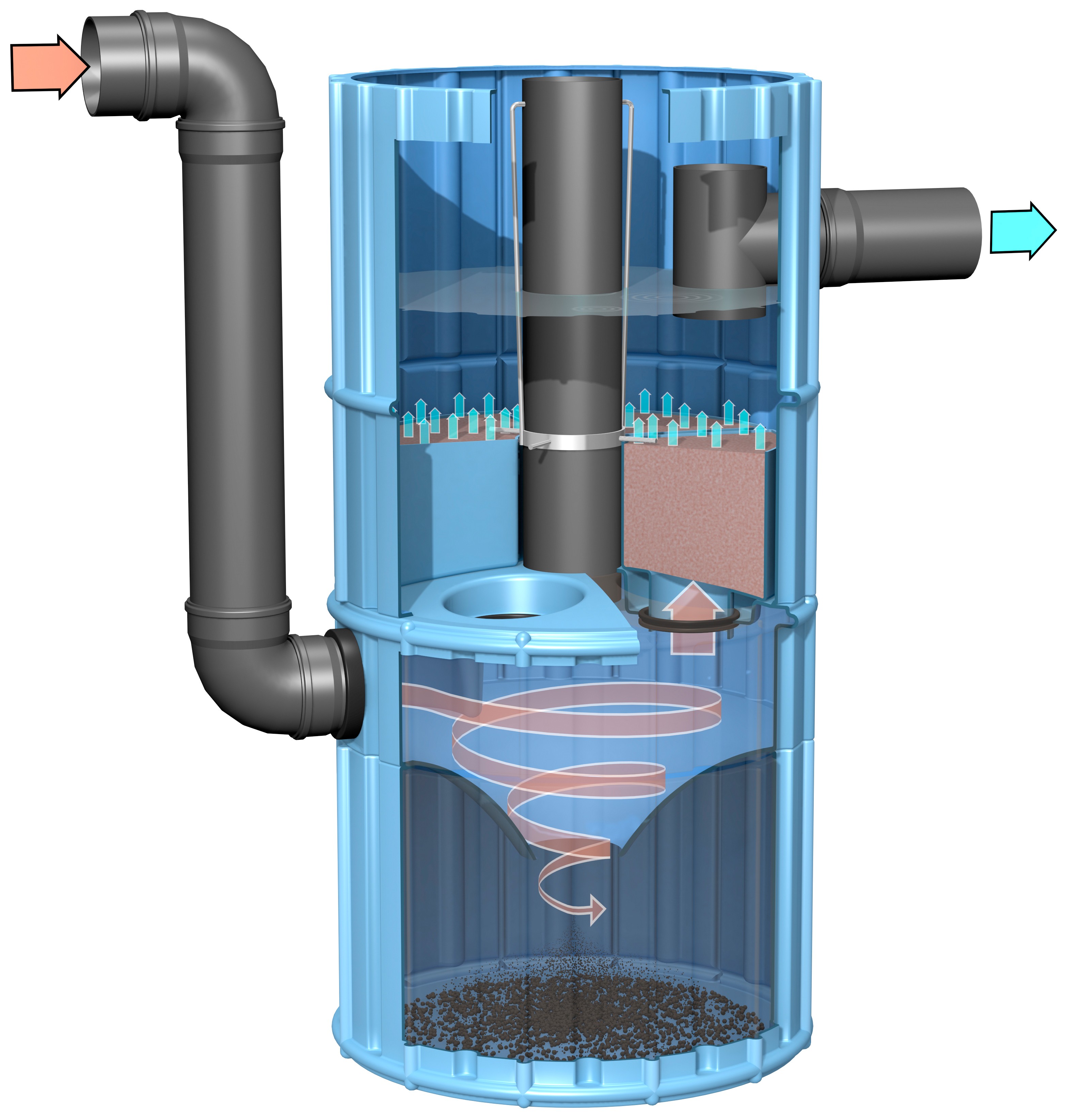Proprietary Separators

Description
A proprietary separator is a flow-through structure with a settling or separation unit to remove sediments and other pollutants. They typically use the power of swirling or flowing water to separate floatables and coarser sediments, are typically designed and manufactured by private businesses, and come in different sizes to accommodate different design storms and flow conditions. Some rely solely on gravity separation and contain no swirl chamber. Since proprietary separators can be placed in almost any location on a site, they are particularly useful when either site constraints prevent the use of other stormwater techniques or as part of a larger treatment train. The effectiveness of proprietary separators varies greatly by size and design, so make sure that the units are sized correctly for the site’s soil conditions and flow profiles, otherwise the unit will not work as designed.
Ability to Meet Massachusetts Stormwater Management Standards
| Standard | Description |
| 2 - Peak Flow | Provides no peak flow attenuation |
| 3 - Recharge | Provides no groundwater recharge |
| 4 - TSS Removal Varies by unit. | Must be used for pretreatment and be placed first in the treatment train to receive TSS removal credit. Follow procedures described in Chapter 4 to determine TSS credit. |
| 5 - Higher Pollutant Loading | Suitable as pretreatment device. |
| 6 - Discharges near or to Critical Areas | Suitable as pretreatment device or potentially a spill control device |
| 7 - Redevelopment | Suitable as pretreatment device or treatment device if it is not possible to provide other BMPs. |
Advantages/Benefits
- Removes coarser sediment.
- Useful on constrained sites.
- Can be custom-designed to fit specific needs of a specific site.
Disadvantages/Limitations
- Removes only coarse sediment fractions
- Provides no recharge to groundwater
- No control of the volume of runoff
- Frequent maintenance is essential
Pollutant Removal Efficiencies
- Total Suspended Solids (TSS) - Varies.
- Nutrients (Nitrogen, phosphorus) - Insufficient data
- Metals (copper, lead, zinc, cadmium) - Insufficient data
- Pathogens (coliform, e coli) - Insufficient data
Maintenance
| Activity | Frequency |
| Inspect in accordance with manufacturer requirements, but no less than twice a year following installation, and no less than once a year thereafter. | See activity |
| Remove sediment and other trapped pollutants at frequency or level specified by manufacturer. | See manufacturer information |
Special Features
Can be custom-designed to fit specific needs at a specific site.
LID Alternative
- Reduce impervious surfaces
- Disconnect runoff from non-metal roofs, roadways, and driveways
Applicability
Because they have limited pollutant removal and storage capacity, proprietary separators must be used for pretreatment only. Because they are placed underground, proprietary separators may be the only structural pretreatment BMPs feasible on certain constrained redevelopment sites where space or storage is not available for more effective BMPs. They may be especially useful in ultra-urban settings such as Boston or Worcester. Some proprietary separators may be used for spill control.
Effectiveness
Proprietary separators have a wide range of TSS efficiencies. To assess the ability of proprietary separators to remove TSS and other pollutants, a proponent should follow the procedures set forth in Chapter 4. The specific units proposed for a particular project cannot be effective unless they are sized correctly. Proprietary separators are usually sized based on flow rate. A proprietary separator must be sized to treat the required water quality volume. To be effective at removing TSS and other pollutants the system must be designed, constructed, and maintained in accordance with the manufacturer’s specifications and the specifications in this Handbook.
Planning Considerations
To receive TSS removal credit, proprietary separators must be used for pretreatment and placed at the beginning of a stormwater treatment train. They can be configured either in-line or if subject to higher flows, off-line to reduce scouring. They must be sized in accordance with the manufacturer’s specifications and the specifications in this Handbook. Proprietary separators used as spill control devices may have to be sized differently than those used for TSS removal.
Design
The design of proprietary separators varies by manufacturer. Units are typically precast concrete, but larger systems may be cast in place. Units may have baffles or other devices to direct incoming water into and through a series of chambers, slowing the water down to allow sediment to drop out into internal storage areas, then directing this pre-treated water to exit to other treatment or infiltration devices. In some cases, flow will be introduced tangentially, to induce swirl or vortex. Units may include skirts or weirs, to keep trapped sediments from becoming reentrained. Some units combine a catch basin with the treatment function, providing off-line rather than in-line treatment.
Generally they are placed below ground on a gravel or stone base. Make sure all units contain inspection and access ports so that they may be inspected and cleaned. During design, take care to place the inspection and access ports where they will be accessible. Do not place the ports in locations such as travel lanes of roadways/highways and parking stalls.
Construction
Install construction barriers around the excavation area to prevent access by pedestrians. Use diversions and other soil erosion practices up-slope of the proprietary separator to prevent runoff from entering the site before construction of the units is complete. Implement practices to prevent construction period runoff from being discharged to the units until construction is complete and the soil is stabilized. Stabilize all surrounding area and any established outlets. Remove temporary structures after vegetation is established.
Maintenance
Inspect and clean these units in strict accordance with manufacturers’ recommendations and requirements. Clean the units using the method specified by the manufacturer. Vactor trucks are typically used to clean these units. Clamshell buckets typically used for cleaning catch basins are almost never allowed by manufacturers. Sometimes it will be necessary to remove sediment manually.